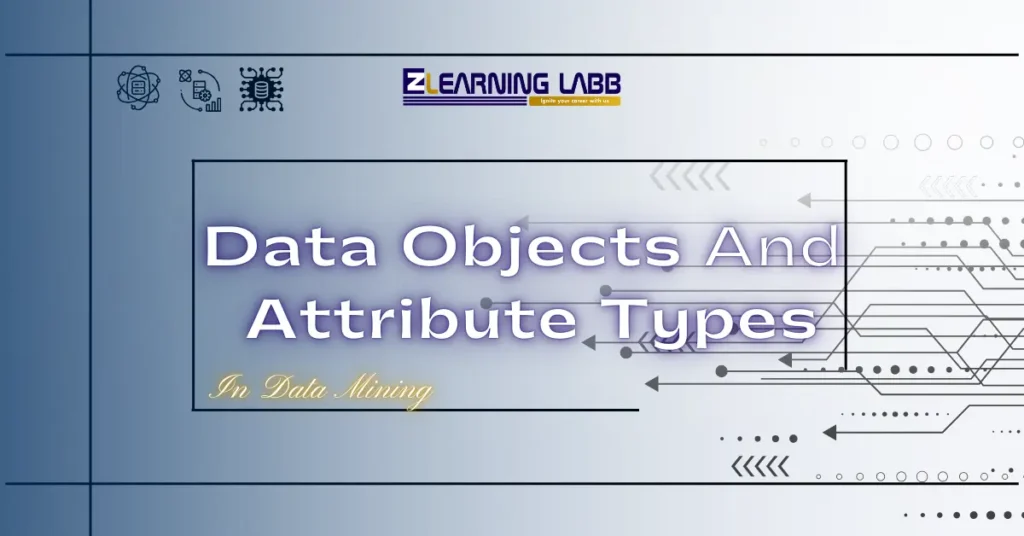Data Objects And Attribute Types In Data Mining: Have you ever wondered how Netflix recommends shows or how banks detect fraud? The magic lies in data mining – a powerful tool to analyse patterns in large datasets.
But here’s the thing: to truly understand data mining, you need to grasp two fundamental concepts: data objects and attribute types in data mining.
In this blog, we’ll explore these concepts into bite-sized pieces, walk you through examples, and show you why they matter. And for those who want to take their learning a notch higher, stay tuned for some valuable tips from Ze Learning Labb!
What Is Data Object in Data Mining?
At its core, a data object is simply an entity. Think of it as a unit of data – a customer, a product, or even a transaction. Every dataset you analyse is made up of multiple data objects.
For instance:
- A data object in e-commerce could be a product like “Red T-shirt.”
- In banking, it could be a customer account.
- In healthcare, it might represent a patient record.
But what makes these data objects meaningful? That’s where attributes come in!

What Is Attribute in Data Mining?
Attributes define the characteristics of a data object. If a data object is the “what,” the attribute is the “how.” They are the descriptive features or properties that help us understand the data object.
Let’s take an example:
- If your data object is a “Red T-shirt,” its attributes might include size, price, colour, and brand.
- For a customer account, the attributes could be age, location, account balance, or transaction history.
In simple terms, attributes add depth and context to data objects. They help us drill down and discover patterns during data mining.
“Without attributes, data objects are just shells – meaningless and incomplete. Attributes give data its purpose.”
Types of Attributes in Data Mining
Now that we know what attributes are, let’s look at the types of attributes in data mining. Attributes are typically divided into two broad categories:
(a) Qualitative Attributes (Categorical)
These attributes deal with categories or labels. They represent non-numeric information. For instance:
- Gender: Male or Female
- Product Category: Electronics, Clothing, or Furniture
Qualitative attributes can be further divided into:
- Nominal attributes: No inherent order (e.g., product colour: red, blue, green).
- Ordinal attributes: A clear order exists (e.g., rating: 1 star, 2 stars, 3 stars).
(b) Quantitative Attributes (Numerical)
These deal with numeric values and allow mathematical operations. Examples include:
- Product Price: ₹500, ₹1500
- Age: 25, 40
Quantitative attributes are further classified into:
- Discrete attributes: Countable values (e.g., number of items purchased).
- Continuous attributes: Measurable values (e.g., height, weight, or temperature).
By distinguishing these attribute types, data scientists can apply the right techniques to extract data effectively.

How Data Objects and Attribute Types Drive Data Mining
Data objects and attribute types are not just theoretical concepts – they are the backbone of data mining! They help determine:
- Clustering and classification: Grouping similar data objects based on attributes.
- Pattern recognition: Spotting trends in datasets.
- Anomaly detection: Identifying unusual patterns (e.g., fraudulent transactions).
Here’s an example:
Imagine you’re analysing customer data for an e-commerce platform. Your data objects are customers, and your attributes include age, gender, and purchase history. By mining this data, you might discover:
- Customers aged 25–34 are more likely to purchase electronics.
- Female customers prefer clothing during festive seasons.
These insights can drive better marketing campaigns, inventory planning, and user engagement.
Examples of Data Objects and Attributes in Action
Let’s make things crystal clear with a practical example.
Dataset: Customer Data for a Retail Store
- Data object: Each row represents a unique customer.
- Attributes:
- Name (Nominal)
- Age (Numeric – Discrete)
- Total Spend (Numeric – Continuous)
- Membership Tier (Ordinal: Silver, Gold, Platinum)
Insights gained:
- Customers in the 30–40 age group spend the most.
- Platinum members contribute 50% of total revenue.
- Most Gold members shop during the holiday season.
By leveraging data objects and attribute types, the retailer can target promotions to the right audience, optimise pricing, and increase customer retention.
Why It Matters?
You might be asking, “Why should I care about data objects and attribute types in data mining?” Well, here’s why:
- Improved decision-making: Understanding your data helps you make better business decisions.
- Efficiency: By classifying and analysing attributes, you can streamline processes.
- Predictive analytics: Want to forecast sales or identify potential risks? It starts with clean data and well-defined attributes.
“In data mining, every data object has a story to tell – if you know how to listen.”

On A Final Note…
Data objects and attribute types in data mining might sound technical, but as we’ve seen, they’re the building blocks of data analysis. By understanding these concepts, you’ll unlock the power to identify patterns, make predictions, and drive meaningful decisions.
If you’re eager to dig deeper, don’t forget to check out the fantastic resources at Ze Learning Labb. Whether you’re a student, a data enthusiast, or a business professional, mastering data mining is just a course away!
“Data mining isn’t just about numbers – it’s about discovering stories hidden within.”
Ze Learning Labb courses are designed for learners who want practical, hands-on knowledge. They simplify complex concepts like what is a data object in data mining or what is attribute in data mining, making them easy to grasp and apply.
Key benefits of these courses:
- Lessons on data objects and attribute types in data mining.
- Step-by-step tutorials on real-world datasets.
- Expert guidance to master clustering, classification, and pattern analysis.
Ready to take your skills to the next level? Explore Ze Learning Labb now!





